
New Mexicans for Science and Reason present

January 11th, 2017 NMSR Meeting: BIGFOOT! Robert Kryder, CEO of Kryder Exploration LLC, on “Field studies and the UNM controversy regarding the study of an unrecognized, large bipedal omnivore in New Mexico, fact and fallacy.”
Kryder began by describing his extensive exploration experience, familiarity with the outdoors, and interest in science and technology. He started investigating reports of novel, large creatures that people brought forth, including many from first responders and other trained observers. Rob says he and colleagues have found much evidence for a possible large hominid, including distinctive large vee-shaped tracks, broken tree limbs (up higher than a man would reach), odors, sounds, direct sightings, copious skat samples, tufts of hair, and more.
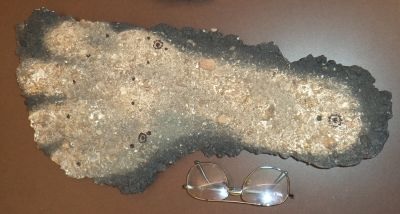
Kryder contributed two samples to a major Bigfoot study by geneticist Bryan Sykes. No DNA could be recovered from the first sample, and the second was “not selected for analysis,” even though it was a fresh sample with good provenance. Rob said, however, that Sykes told the AP that all the samples had been tested. When the Sykes study was published, all samples described had mundane sources (bears, dogs, etc.)
When another opportuniy for testing came up through ISU’s Jeff Meldrum, Meldrum ending up just sending it to Sykes, where it was not tested again, to Kryder’s chagrin.
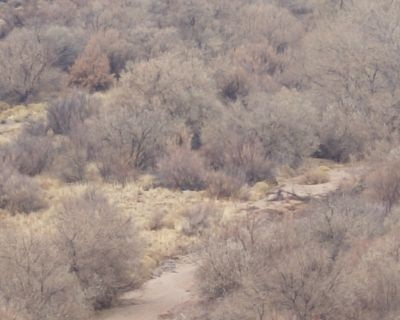
Is the dark spot at the center Sasquatch?
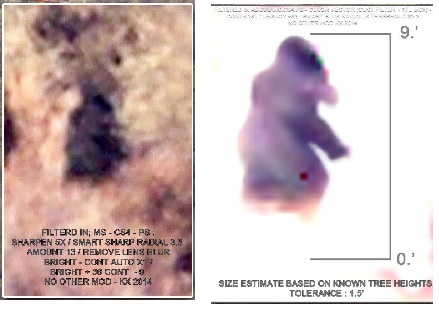
Blow-up and analysis of the preceding figure.
Kryder discussed his theories on Sasquatch- their extreme shyness and intelligence, ability to forage on typical southwest plants, and so forth. He presented pictures (above) he was convinced show a Sasquatch in the field.
A lively Q&A Session followed the talk. Audience members suggested that the quality of evidence provided needed to be better – say, hi-res close-up videos rather than far-off grainy photographs. And, why haven’t any sasquatch fossils ever been found? Of course, good DNA results would go a long way toward establishing the phenomenon.
But, what creature is leaving all this evidence? Richard Feynman’s comment comes to mind: “In order to make progress, one must leave the door to the unknown ajar.” However, one should also keep in mind the skeptics’ motto, “Extraordinary claims require extraordinary evidence.”
You can check out Kryder’s evidence online, at the KX Cryptid-Hominid Research Group, and at Kryder Exploration.
NMSR thanks Rob Kryder for a very interesting presentation.

October 31st, 2016: Taxpayers on the hook for UNM Bigfoot expedition
On October 31st, 2016, KRQE's '13 Investigates' with Larry Barker featured a segment titled "Taxpayers on the hook for UNM Bigfoot expedition."
This article has a full transcript, and additional information.
Some screen captures and quotes follow.
The article has been picked up by the Daily Mail (UK).)
There have already been repercussions ("University executive director under fire for Bigfoot hunt").
Local Bigfoot activist Rob Kryder has graciously agreed to present "Field studies and the UNM controversy regarding the study of an unrecognized, large bipedal omnivore in New Mexico, fact and fallacy" at our January 11th, 2017 NMSR Meeting.
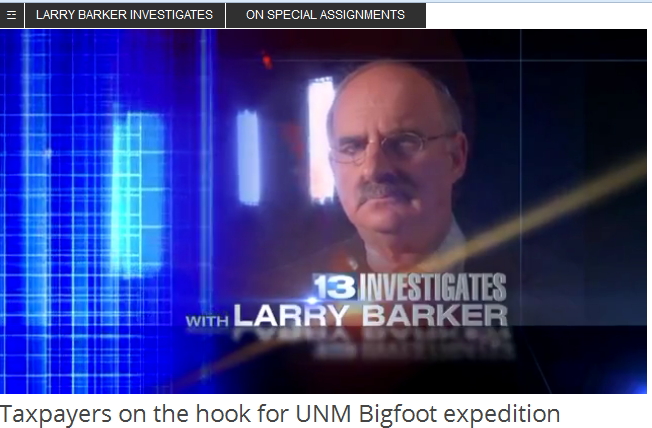
A KRQE News 13 Investigation By Larry Barker
Published: October 31, 2016, 10:00 pm Updated: November 1, 2016, 6:47 pm
GALLUP, N.M. (KRQE) – There’s only one way to describe what’s happened at the University of New Mexico. Bizarre.
“I didn’t know about this until you contacted us to bring it to our attention,” said UNM President Dr. Robert Frank.
At the center of this controversy is a legendary creature called Bigfoot. In the animal kingdom, Bigfoot is right up there
with the Loch Ness monster, unicorns and werewolves. According to folklore, Bigfoot is a hairy, human-like beast that
supposedly lives in the woods. Even though there has never been any scientific evidence the creature actually exists,
UNM’s Gallup campus is front and center in the hunt for Bigfoot.
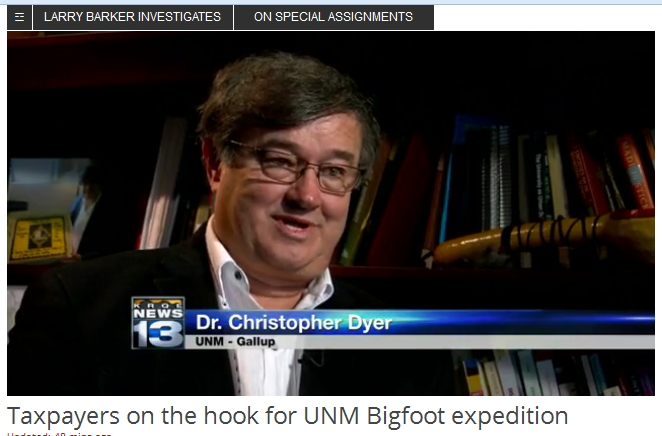
Leading the charge for the university is Dr. Christopher
Dyer.
“I haven’t seen it but I’ve heard it. I’ve had a rock thrown at me by one at night I think. And it certainly smelled.
That’s because they have a very strong odor,” says Dr. Dyer.
From his office in western New Mexico, Dr. Dyer heads up UNM’s Gallup campus. When he’s not presiding over students and
faculty Dr. Dyer traipses through the outback investigating legendary creatures. Spend a few hours with Dr. Dyer and he
will regale you with stories about the Bigfoot hairs he’s collected, the suspicious footprints he’s found and the evidence
he’s collected.
Dr. Dyer claims he pursues Bigfoot only on his own time. However, a KRQE News 13 investigation finds Dyer hit up taxpayers
with more than $7000 in Bigfoot related expenses.
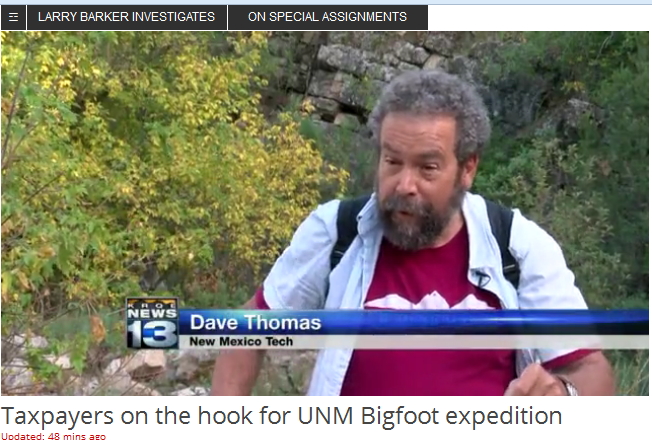
“When you’re expending the resources of taxpaying citizens on what is completely pseudo-science, that’s a betrayal of the public trust. That’s a betrayal of the mission of the university,” according to lecturer and New Mexico Tech instructor Dave Thomas.
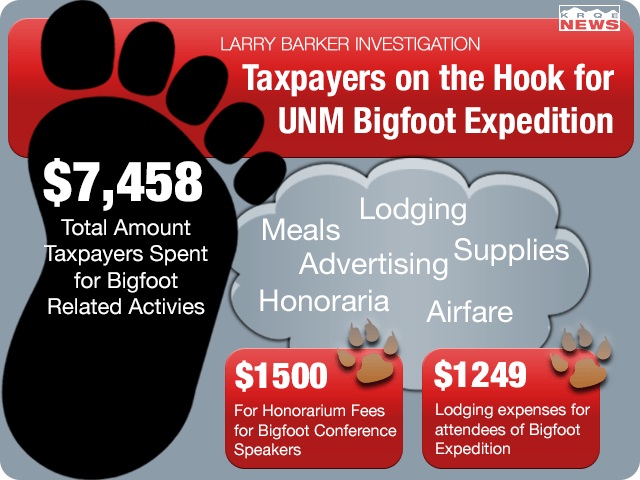
In February, Dyer organized a two-day, on-campus Bigfoot conference, “Bigfoot in New Mexico: Evidence, Ecology, and
Behavior.” The guest speakers were billed as “renowned expert” Dr. Jeff Meldrum and “New Mexico naturalist” Rob Kryder.
“It was the largest and most well-attended event in the history of this campus,” said Dr. Dyer.
UNM shelled out thousands of dollars for advertising, meals for the guest speakers,
airfare, hotels and per diem. Self-professed Bigfoot expert Dr. Jeff Meldrum was handed a $1000 honorarium plus expenses.
“There are these beings that as has been suggested have been here for a long time obviously. But that are remnants now.
They’re certainly not as numerous as they were at one time,” Meldrum told the conference crowd.
The other guest speaker, Rob Kryder, was paid a $500 honorarium plus expenses.
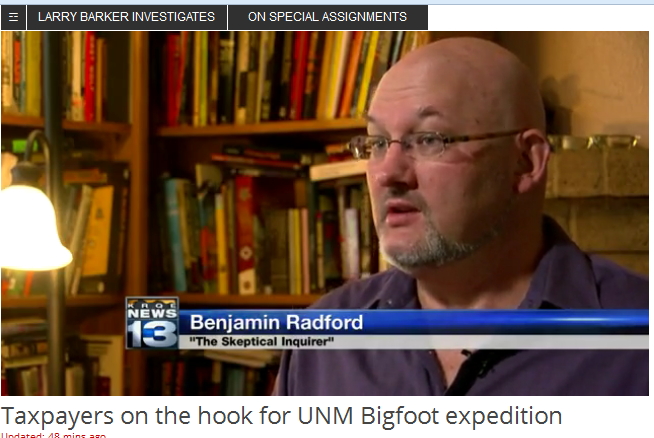
“The presentation in Gallup was not balanced,” said Ben Radford who is a researcher, author and Managing Editor of the scientific journal, The Skeptical Inquirer. “(There were) two people who professed to be experts on the subject of Bigfoot giving this talk. And yet where were the skeptics? There are many Bigfoot skeptics here in New Mexico they could have “I didn’t know where to find such skeptics frankly,” conference organizer Christopher Dyer said.
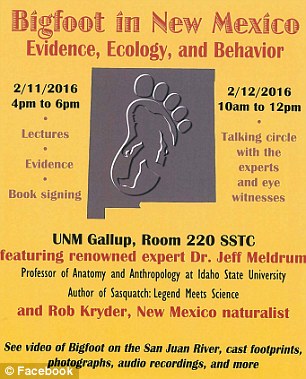
Following the two-day conference, Dr. Dyer loaded up his van and hit the road in search of the elusive beast. It may be
the first publicly funded Bigfoot expedition in history. Armed with binoculars and other paraphernalia, Dr. Dyer and some
of his pals headed to the Sandia’s in search of Bigfoot.
Even though there were no students or faculty on the expedition, UNM paid for everything. There were hotels in Santa Fe
and Albuquerque, meals, and mileage. Taxpayers also paid $140 for seven pairs of snowshoes for the field trip
participants.
KRQE News 13 asked Dr. Dyer if he was able to catch a glimpse of Bigfoot. “No. But we looked at Habitat. We didn’t see
it,” Dyer said.
“I’d have to say it was pretty much a blown waste of money because we did not find evidence because of the snow. It was
just impossible to get around out there. So in that case, yeah would we spend money on that again? Absolutely not,” Dyer
said.
One of the participants on the Bigfoot expedition to the Sandia’s was Bigfoot believer George Harvey. UNM paid for all of
Harvey’s expenses including meals, transportation and hotel rooms. According to Dyer, George Harvey is, “very poor
actually. And his whole family is poor. So no I don’t think he could have paid for it itself.”

KRQE News 13 asked Dave Thomas about the odds of finding Bigfoot in the Sandia’s. “I think the odds against would be billions to one. It makes as much sense for UNM to have a Bigfoot hunt in the Sandia’s as it would be for UNM to host a field trip to find the pot of gold at the end of the rainbow,” Thomas said.
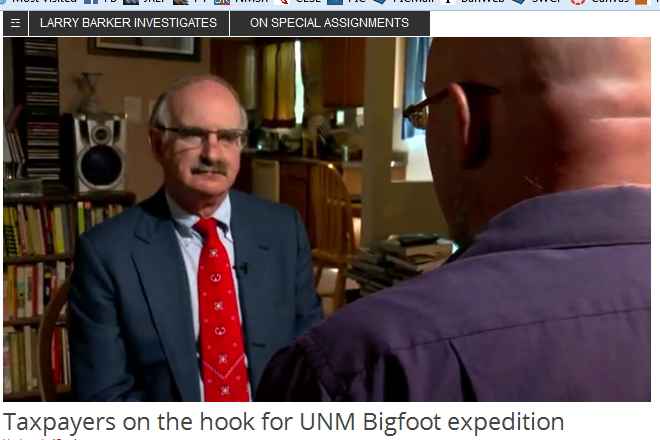
“Well you know if you want to spend the day hiking in the Sandia’s you go for it. I would just say don’t use the public’s money,” Ben Radford said. “The track record of success for Bigfoot searches is exactly zero. It’s not one percent. It’s not 10 percent. Not 30 percent. Exactly zero. So there has never been a successful Bigfoot search.”
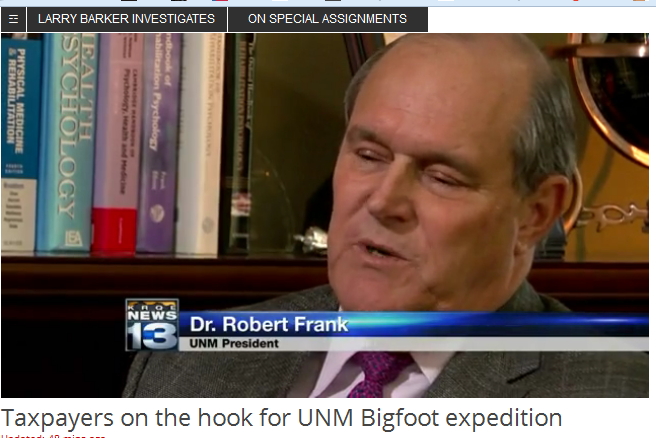
“I use discretionary funds for things that I think are of merit. That could include field work of some kind or research of
some kind,” Dr. Dyer said.
“People use monies from the taxpayers to do research. For Bigfoot or whatever,” according to Dyer.
When you add it all up, since February, taxpayers have shelled out $7,458 for Bigfoot related activities.
KRQE News 13 asked State Senator George Munoz, who lives in Gallup, if he had spoken to Dr. Dyer about his passion for
Bigfoot.
“No I haven’t (spoken to him). I don’t know if I can keep a straight face. And then ask him why he’s spending this amount
of money on something that doesn’t really exist,” Senator Munoz said.
KRQE News 13 asked Senator Munoz how does he explain the UNM Gallup situation to his colleagues in the State Senate? Munoz
said, “I can’t. How can I say we have a director that’s hunting a mythical legend. They’ll laugh me out of the room.”
Commenting on the use of public money to fund campus Bigfoot research, Dave Thomas said, “It’s not expanding the frontier
of science. It’s wasting time and resources on something that is as ephemeral as leprechauns. It’s really a waste of
scientific resources.”
Senator Munoz, who serves on the State Legislative Finance Committee, has a message for Dr. Dyer.
“Pay back the money,” Munoz said.
Dr. Dyer’s publicly financed Bigfoot expeditions may be coming to an end.
“Dr. Dyer needs to be much more thoughtful about how he undertakes these activities. The type of expedition that just took
place was not appropriate and will not occur in that manner again,” said UNM President Robert Frank.
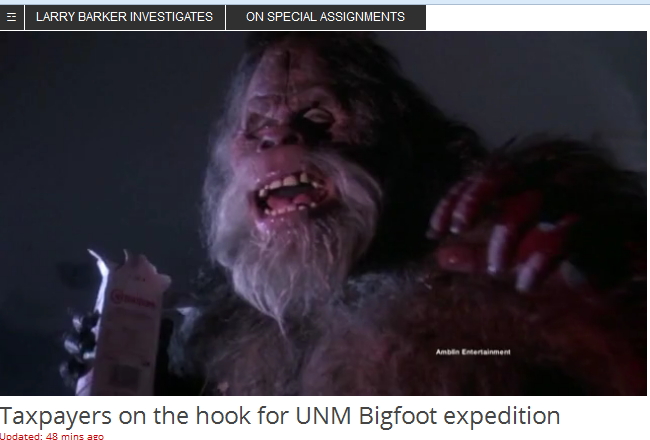
Bigfoot, as shown in "Harry and the Hendersons"
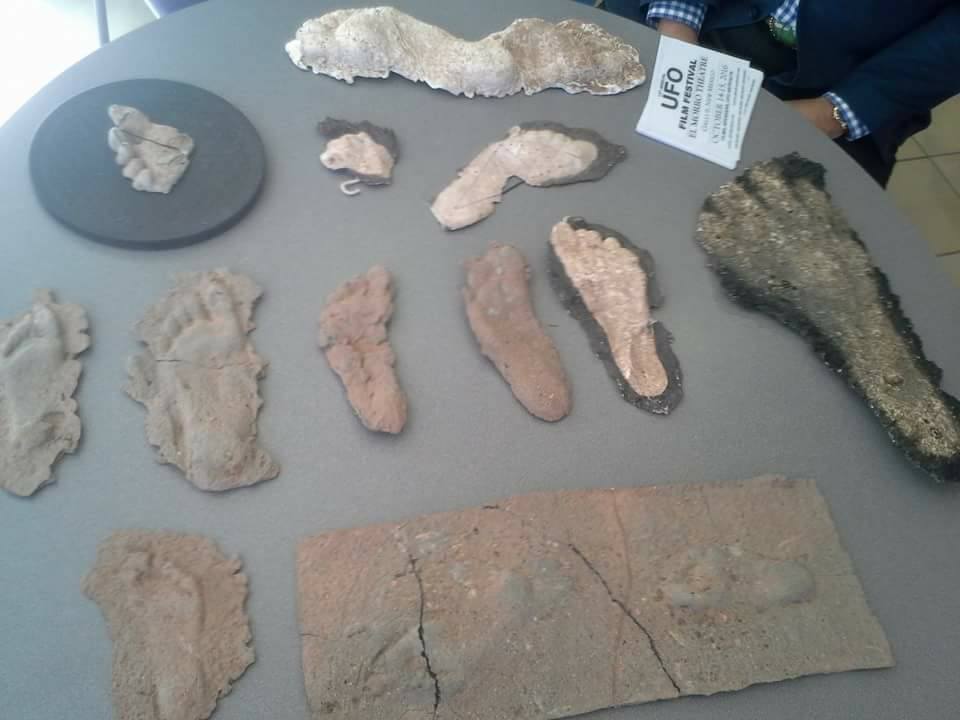
This is some of the evidence being claimed, learn more at the January 11th meeting.
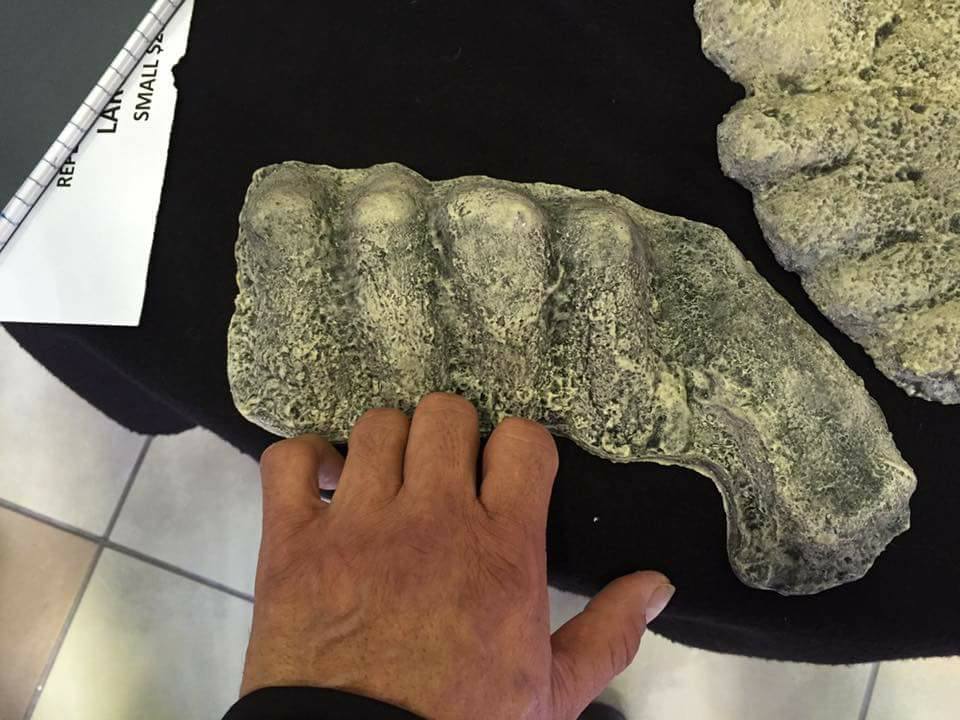
More evidence.
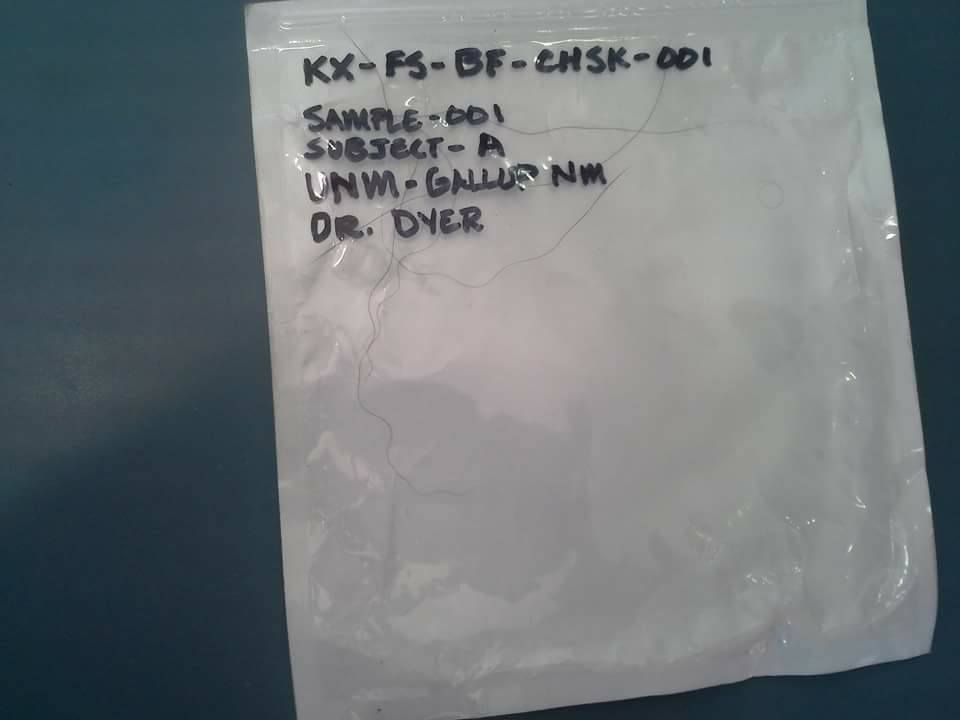
Hair samples?

Local Bigfoot activist Rob Kryder will present "Field studies and the UNM controversy regarding the study of an unrecognized, large bipedal omnivore in New Mexico, fact and fallacy" at our January 11th, 2017 NMSR Meeting.
